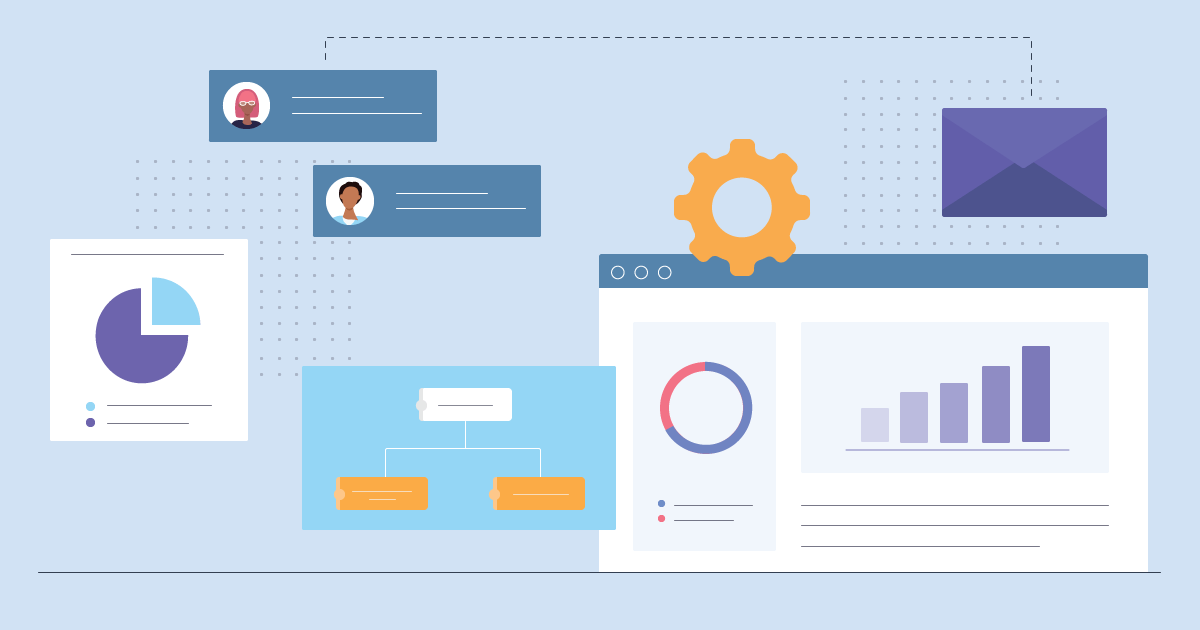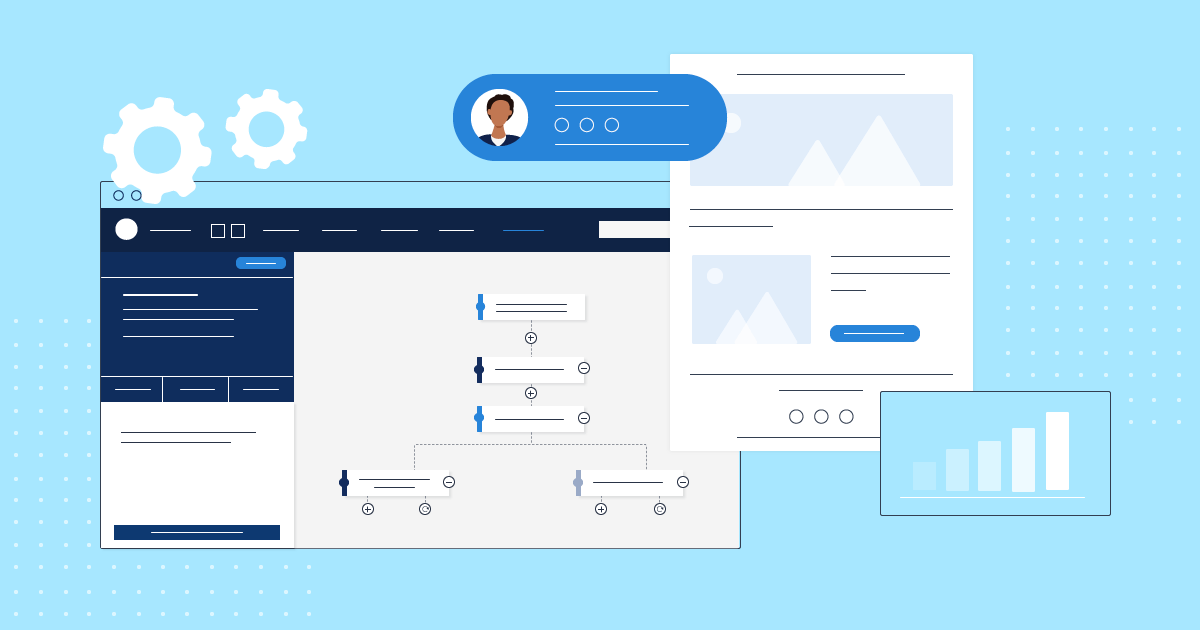
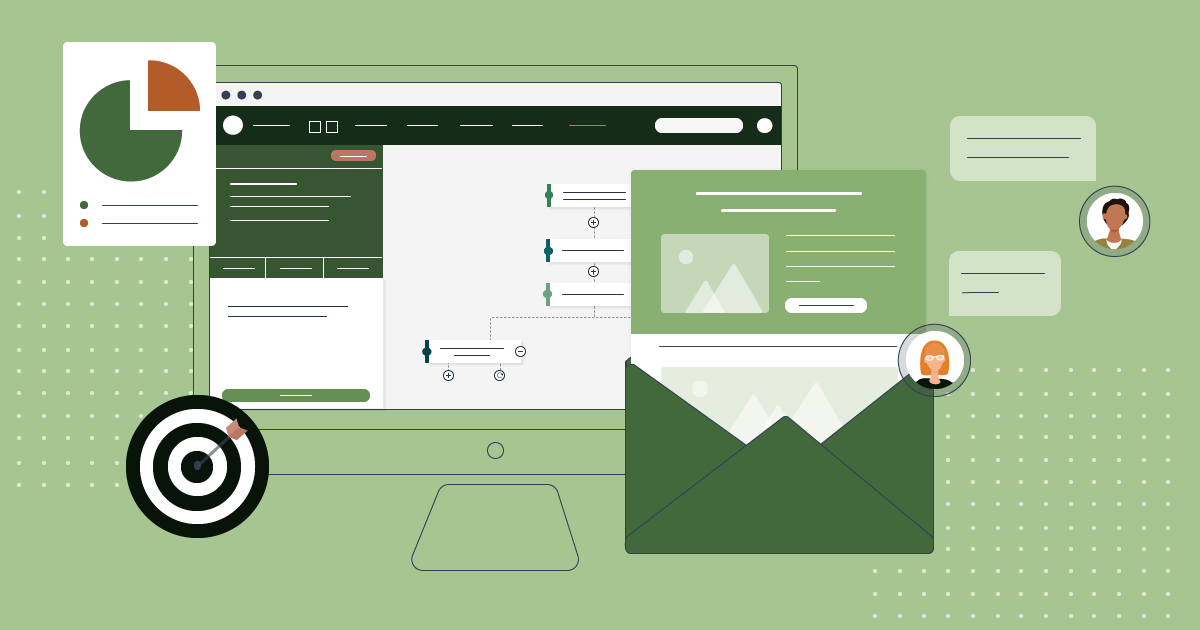
Drip Marketing: The Ultimate Guide With Examples [2025]
Digital marketers always look for cost-effective, game-changing promotional tactics to meet their goals. From social media to content marketing and SEO, they try to reach out to new audiences and nurture existing ones.
One of the most popular methods, which is easily personalized and automated, is email marketing. In this guide, we’ll focus on drip marketing campaigns, which enable professionals to send the right messages to the right people at the right time.
Learn more about:
- The definition of drip marketing
- The benefits of building drip email campaigns
- How to make an effective drip marketing strategy
- What email campaigns to prioritize for your business
Let’s take it from the top!
What Is Drip Marketing?
It’s a strategy that involves sending automated message sequences, usually triggered after specific user actions, such as signups or purchases. For example, you can create a welcome email series for new subscribers to start nurturing them from day one.
Drip campaigns can also take place on channels like email, social media, and direct email marketing. However, email drip campaigns are more common and easy to set up, with more fruitful outcomes.
There are some alternative names for drip email campaigns:
- Lifecycle emails
- Automated email campaigns
- Autoresponders
- Triggered emails
All you need is a top-notch email marketing platform with a dedicated feature to create these sequences. Want to see an example? Here’s a quick view of an onboarding drip campaign from Moosend to get a better grasp!
Why Is Drip Marketing Important For Businesses?
Let’s explore some of the key benefits of marketing automation and drip campaigns for your business:
Increase Engagement
When a consumer completes a specific action on your website, they are interested in your brand. By creating an automated sequence with relevant content, you can engage them more and convert them. However, it’s best to avoid overwhelming non-openers with undesirable emails and stick with those who show genuine interest in your campaigns.
Imagine that you have project management software, and someone downloads one of your infographics. How can you nurture them further? You could follow up with relevant resources and an email with a demo link to move these leads slowly down the funnel.
Generate Revenue
Apart from nurturing your target audience with insightful content, you can also run automated campaigns to drive more ROI. According to DMA, 75% of email revenue comes from triggered, personalized campaigns compared with other email types.
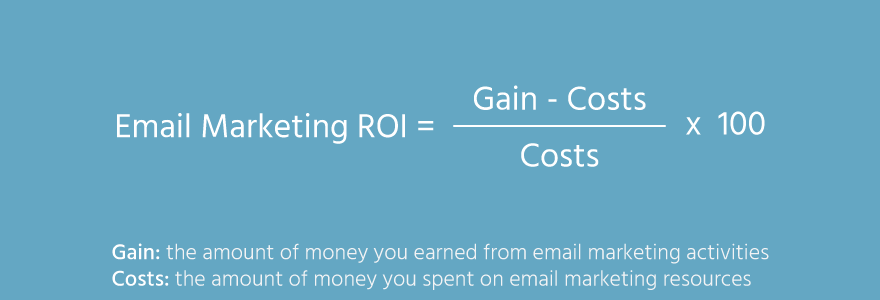
For example, you can set up abandoned cart email campaigns to nudge website visitors to purchase something they’ve recently left in their shopping cart. In addition, setting up cross-sell and upsell campaigns will let you nurture some of your previous customers based on their purchased products and increase your sales.
Βoost Brand Awareness
Sending relevant and timely content consistently to your subscribers’ mailboxes elevates your brand visibility to people who have already expressed an interest in your brand. The more touchpoints and information you share, the more chances to stick in their head.
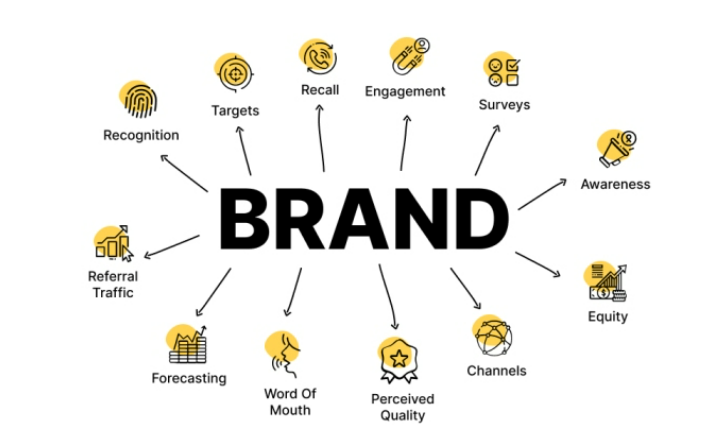
Remember, getting their opt-in first is essential before setting up your drip campaigns. If not, you may have adverse outcomes, like low open rates and high spam complaints, and lose potential customers over time.
Reduce Costs
Overall, email drip marketing is cost-effective, allowing you to target new leads and existing customers in simple steps. All you need is an email automation platform that supports these types of emails to build the proper automated workflows for your audience.
Finally, you can save money from costly marketing campaigns using premade, customizable email templates and setting the proper triggers and conditions. Moreover, it allows you to exert more energy on other promotional initiatives without compromising your outreach quality.
How To Set Up Drip Marketing Campaigns
If you want to make or improve your drip email marketing strategy, here’s what to prioritize:
1. Pick An Email Marketing Software
Creating drip email campaigns gradually is inefficient, especially when you have a long email list. Instead, you need a first-class email marketing tool like Moosend or Mailchimp to keep all processes in one place. Plus, many platforms offer premade recipes to help you set up different types of drip campaigns faster.
For example, here is a list of ready templates offered by Moosend:
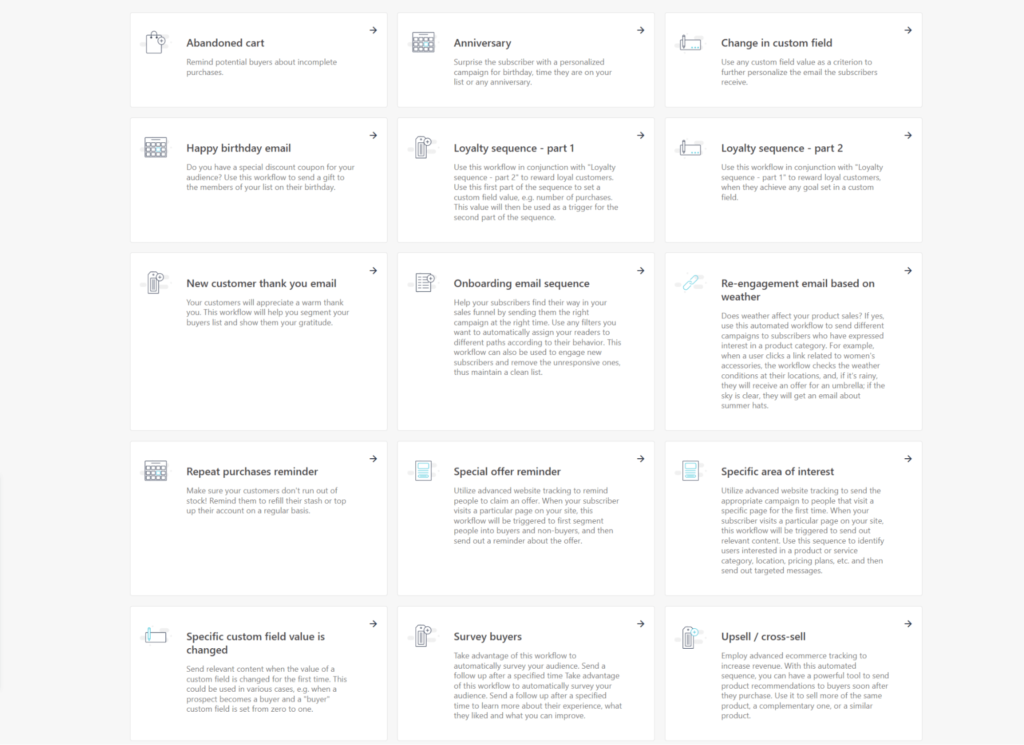
If you don’t have an email marketing platform yet, make sure that your new marketing tool has compelling marketing automation features, including premade templates, an intuitive builder, mobile responsiveness, and a high deliverability rate to reach maximum results.
Plus, getting a platform with behavioral-tracking tools to collect the correct data and an SMTP server to let you plan transactional emails is wise. You can also integrate it with your CRM solution for better performance.
Finally, if you’re a novice, you must collect your customers’ and visitors’ email addresses to nurture leads and nudge customers. You can create dedicated landing pages or place signup forms inside your website, static or pop-up, to grow your email lists.
Want to find a marketing automation platform that suits your needs? Here’s a list of relevant tools to get it faster!
2. Set Your Goals
Before creating a drip campaign, it’s essential to have a clear goal to deliver fitting email content. For example, an onboarding sequence aims for customer success and retention, while an up-sell campaign is made to increase sales.
You can apply the SMART framework to build more effective campaigns for higher open and click-through rates. Setting realistic and timely objectives is key to the success of your drip marketing.
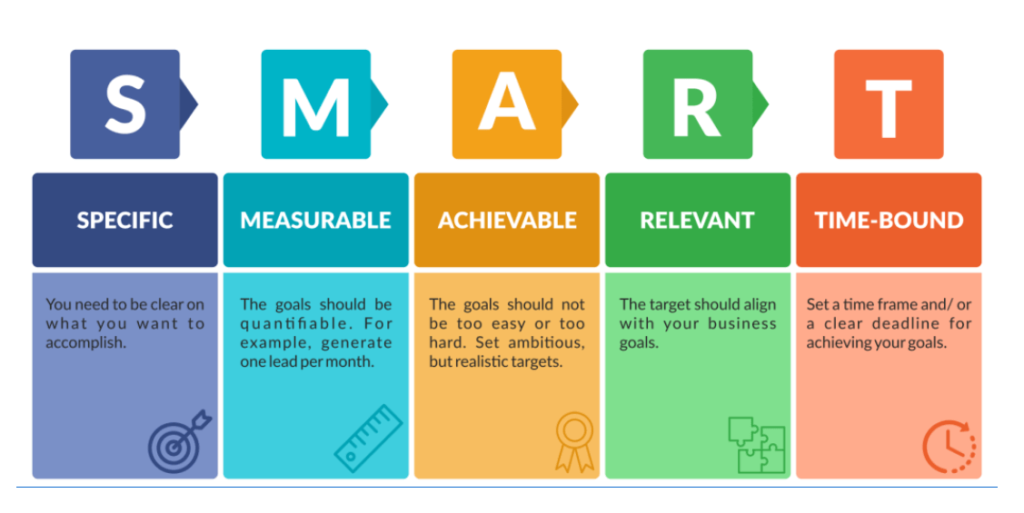
Finally, it’s essential to know your target audience to succeed in this process. Build a customer journey map and buyer persona profiles to understand their pain points, habits, and consumer preferences in depth. Thus, you’ll manage to create relevant and timely nurturing campaigns that will elevate your conversion rates.
3. Craft Your Automated Sequences
It’s time to create your first drip campaign! The first step is to write enticing copy based on the goals of each email marketing campaign of a series that will attract the readers’ attention.
Create a linking point along the email campaigns you schedule regarding messaging, following your brand guidelines. Make beautiful campaigns that entice customers, including all essential elements such as your logo, an email footer, and a call-to-action button. Remember that the CTA should stand out from the rest of the text to get more clicks.
Next, follow your platform’s automation instructions to choose the actions, triggers, and conditions for your drip sequence. Consider the exact stage the subscriber finds themselves in to choose the number of emails they should set up. This could be anything between three and seven, with the drip campaign goal and industry playing a vital role in this decision.
Look what an abandoned cart drip campaign looks like on Moosend’s platform:
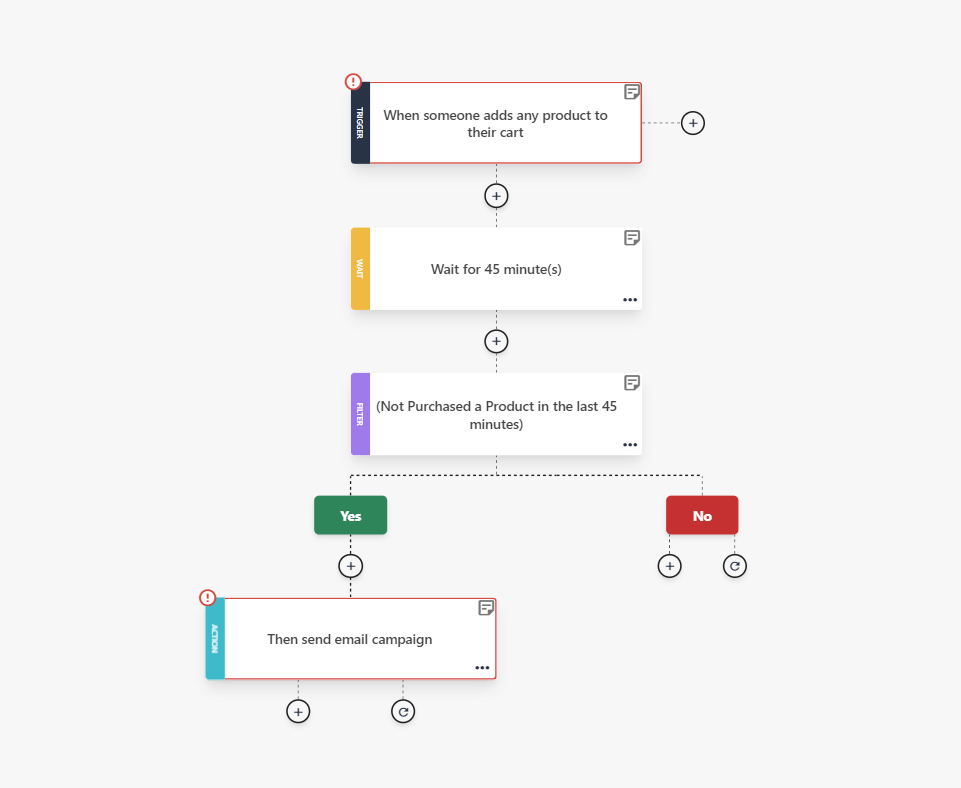
4. Analyze Your Campaign Performance
To ensure that your drip campaigns contribute to your promotional efforts and sustain your ROI, you should monitor key email metrics regularly. Let’s have a look at the most important:
- Open rate
- Click-through rate
- Bounce rate
- Conversion rate
- Spam complaints
- Unsubscribes
Utilize the reporting feature of your email platform to update your log and combine it with a first-class tool such as Google Analytics to get a better view of what works or needs improvement in each stage. For example, the data could signal that you need to increase the number of triggered emails or what incentives work best for your audience each time.
You can also use A/B Testing from time to time to experiment with a different version of an email element, such as the subject line, before it reaches the majority of your new subscribers.
9 Drip Campaign Examples To Get Inspired
Let’s see some email campaign examples that can become a solid part of a drip marketing campaign series to boost lead generation and move consumers down the sales funnel:
1. Seatgeek’s Welcome Email Campaign
Subject Line: Welcome to SeatGeek! Please Verify Your Email Address

Why it works: This is the first email people receive when they join Seatgeek’s list. This welcome email requires new subscribers to give their double opt-in to ensure they’ve received the correct email address.
This campaign also showcases important information about what new customers and subscribers can expect from the brand. As part of these series, you can also schedule a follow-up email to collect the subscriber’s preferences and, based on that data, plan a subsequent campaign with relevant suggestions.
2. Moosend’s Onboarding Email Series
Subject Line: You’re officially a part of the Moosend family!
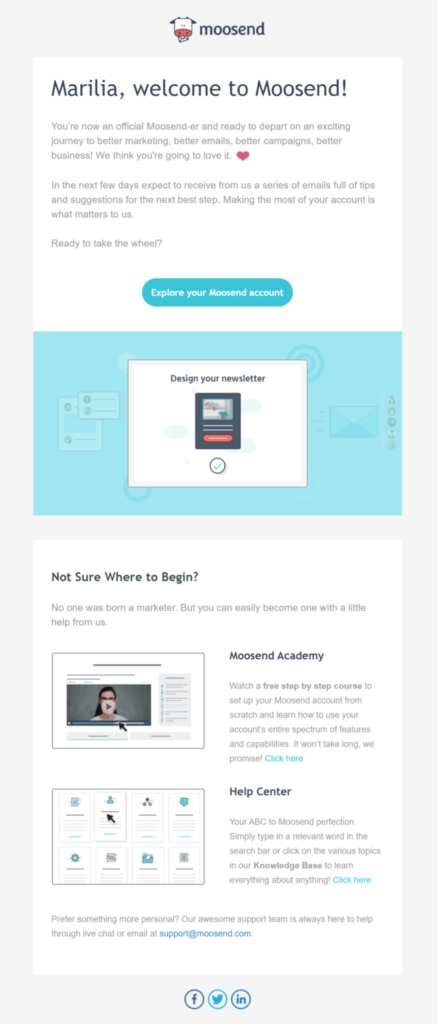
Why it works: To ensure customer success and, subsequently, retention, it is essential to set up an onboarding email series with all the details they need to thrive with your product/service.
For instance, Moosend included links to their Academy section in their first onboarding email, where users can watch helpful tutorials to set up their first emails. They also added a button to the help center for those who need simple answers to their questions.
What else can you place to these campaign series? You can continue with feature descriptions or step-by-step guidelines on how to use their new products/tools effectively.
3. Surreal’s Lead-nurturing Campaign
Subject Line: The rumours ARE NOT true

Why it works: SaaS and eCommerce businesses with long and complex customer journeys need drip marketing tactics to nurture their audiences and convert them. You can share different email content types based on the buyer’s stage they’re in, such as case studies or top-of-mind resources to stand out from your competitors.
For example, this nurturing email campaign from Surreal includes customer testimonials and an image from one of their delicious products to entice skeptical consumers. The CTA button leads straight to the shop to boost sales. If you go for a similar drip campaign, you can send a follow-up email with a coupon for non-openers to increase conversions.
4. South Dakota’s Re-engagement Campaign
Subject Line: Let’s Reconnect ❤️

Why it works: Many businesses automate win-back email series to re-engage relapsed customers. These emails can take many forms: You can start with your latest business updates, as South Dakota did in the example above, and continue with a charming incentive.
You can schedule a third email with a survey to collect their feedback and optimize your services. Finally, before removing them from your list, send them a final email and allow them to stay with you if they wish. This win-back email campaign guide will help you structure your email strategy with success.
5. Blu Dot’s Abandoned Cart Email
Subject Line: Wait up. Your order is not complete.
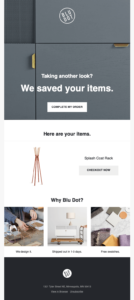
Why it works: One of the best email marketing strategies is sending cart abandonment emails. These triggered campaigns usually receive high open and click-through rates, as consumers have already expressed interest in specific products.
Look at how Blu Dot approached it; they added the product left in the visitor’s cart, including information on why consumers should choose their business, like shipping and free swatches. In short, you can schedule similar drip campaigns to nudge prospects until you finally convert them.
6. Blinklist’s Recommendation Email
Subject Line: Top 3 Blinkist titles that everyone’s loving

Why it works: To boost your ROI even more, you can set up automated emails with recommended products/services to subscribers. However, to increase conversion rates, make sure to segment your audience based on criteria such as previous purchases or demographics.
For example, Blinklist decided to portray their most popular audiobook titles to activate the FOMO effect (Fear of missing out) and motivate subscribers to join the crew. You can also plan these drip campaigns in the form of upsell and cross-sell emails.
7. Hubspot’s Renewal Drip Campaign
Subject Line: Your HubSpot account will be deactivated in 30 days
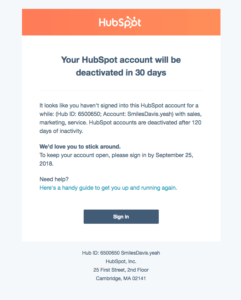
Why it works: If you offer a plan-based software solution, it’s essential to build a renewal or deactivation drip campaign series. Here, Hubspot scheduled an email campaign to inform inactive subscribers that in 30 days, their accounts will be deactivated.
Therefore, you can build subsequent triggered campaigns to motivate them to sign in as the time comes closer. This is similar to win-back emails; hence the copy should be straightforward to get them to act fast.
8. Asana’s Webinar Drip Campaign
Subject Line: How can your team overcome disruption in our distributed world?
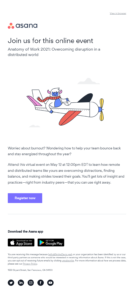
Why it works: If you’re organizing an event or webinar, drip marketing will help boost registrations and create a “full house” event. Building a series of emails with diverse content is critical to indulge your attendees in joining you.
For instance, you can start with an event invitation email with clever subject lines to get more open rates and continue with short teasers, like videos from similar events or an introduction of speakers. Finally, schedule a triggered campaign for a few days or hours based on the nature of the event as a reminder.
The Takeaways
In a nutshell, drip marketing can plan an organic role in your promotional efforts and even contribute to brand awareness and revenue generation over time. To thrive, you need to craft a complementary email automation strategy to power up existing campaigns.
If you need a first-class email automation tool with amazing features and scalable pricing, sign up for a Moosend account and start for free!
Drip Marketing FAQs
Need some quick answers? We’ve got your back!
1. What are the benefits of a drip campaign?
It’s a cost-effective, time-saving solution that helps businesses increase engagement, boost brand awareness, and generate revenue. Here are some more drip campaigns you can run today!
2. What is the best time to send a drip campaign?
The best time for marketing emails is usually in the morning, around 10 am, but it’s best to understand what works best for your target audience with A/B testing before scheduling them.
3. What is an example of a drip campaign?
The most popular drip campaigns are: 1) Welcome, 2) Onboarding cart, 3) Lead-nurturing, 4) Winback, 5) Abandoned, 6) Recommendation, 7) Event, and 8) Renewal email series.





 Published by
Published by
